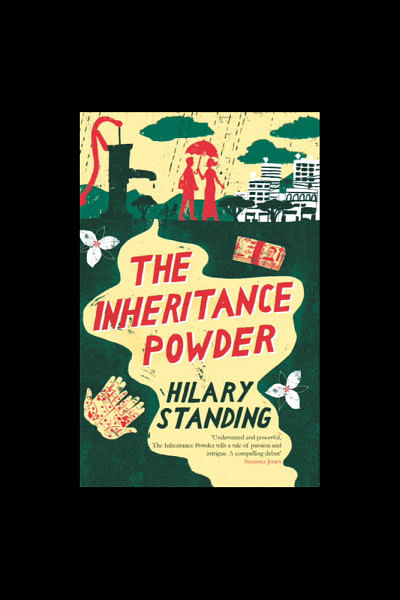Poisoned Wells: A Tender Tale of Love and Death

when the well is dry,we learn the worth of water"—Benjamin Franklin
**
"If we lived in the desert and our lives depended on a water supply that came out of a steel tube, we would inevitably watch that tube and talk about it understandingly. No citizen would need to be lectured about his duty toward its care and spurred to help if it were in danger. Teachers of civics in such a community might develop a sense of public responsibility, not only by describing the remote beginnings of the commonwealth, but also how that tube got built, how long it would last, how vital the intake might be if the rainfall on the forested mountains nearby ever changed in seasonalhabit oramount. It would be a most unimaginative person, or a stupid one, who could not see the vital relation between the mountains, the forests, that tube and himself."—Isaiah Bowman
**
Hilary Standing's debut novel, The Inheritance Powder, was originally published in the UK in October 2015, and short-listed for the Yeovil Literary Prize in the same year. We in Bangladesh, however, were unaware of this fine novel's existence, until UPL took the laudable decision to print the Bangladeshi edition and launch it at theDhaka Literary Festival in November 2016.I have borrowed the first part of this review's title from the heading given to the book-launch session in the DLF 2016 programme, but for a while, as I read the book, I played with the idea of using the quasi- allegorical, Death by Water.In the end, I plagiarized "Poisoned Wells" because it focuses more sharply on the tragic and deadly, carcinogenic effect of mass arsenic poisoning in large parts ofrural Bangladesh.This, in essence, is the scaffolding upon which Hilary builds a powerful tale of a botched development programmeand the complex nature of foreign-aid projects in poor countries."Poisoned Wells" merges idea and image in one epithet, thereby capturingtheinescapable and sinister pall of doom hovering over the lives ofvillagers forced to rely on nature's randomness, on nature's fickle ebb and flow of benevolence and malevolence. Of course, every Bangladeshi knows how Nature can be "red in tooth and claw", how our country's unique geography can devastate land and huts and blood and guts. We live from one crisis to another, from one natural calamity to another. Ironically, human intervention for the greater good can sometimes make things worse.
The Inheritance Powder was first published by RedDoor publications, and, as Hilary pointed out in conversation with me in November 2016, it was such a shame that it was only available at Amazon.com. It is indeed a boon for us that Hilary had the impulse to offer the manuscriptto UPL for publication and wider circulation in Bangladesh. Hilary is an emeritus fellow at the Institute of Development Studies, University of Sussex. She has a doctorate in social anthropology, specializing in health systems development and reproductive health. She has lived and worked for long periods in India and Bangladesh, and has worked on issues of gender and health sector reform in many other countries. In an essay published on 3 November 2015 in the Institute of Development Studies (IDS) blogtitled Fiction and Development, Hilary writes: "Over a decade ago, I decided to write a novel about 'development'. The decision came about partly because I have always been a secret scribbler of…short stories and narrative of events that have engaged me in ways that social science doesn't quite workfor. But particularly because the story behind the novel presented itself to me unbidden in a country where I have worked and lived and that is very close to my heart. That country is Bangladesh and the story which came to haunt me is one of good development intentions gone disastrously wrong."
The Inheritance Powder tells the tale of the world's worst mass chemical poisoning, a terrible story of 50-80 million people poisoned by arsenic released from under layers of sediment in deltaic regions of India and Bangladesh by the action of constructing deep bore wells. Hilary puts some harsh questions in her blog, "Where does accountability for this disaster lie?Could it have been foreseen? Which actors and agencies should take responsibility for resolving it?"She goes on to explain the narrative design of her novel: "I wanted to…explore these troubling questions through the prism of individual lives, to imagine how characters caught up in this situation in different ways might respond….The novel is told from the alternating viewpoints of a visiting British consultant working for a European development agency that wants a grand plan for dealing with arsenic, and a Bangladeshi woman leader of a grass-roots organization that is working to develop local solutions."
After I finished reading the novel, I phonedthe Director of the Institute of Disaster Management, University of Dhaka, and quizzed her about local solutions. She explained that, given the magnitude of the problem of arsenic poisoning, and despite funding from the World Bank and The Netherlands, and despitegood faith and intervention by NGOs and civil society leaders, the cost and complexity of testing for arsenic contamination made amelioration and resolution of the crisis very difficult.The work is hard, but progress is slow.Funds are provided for the construction of the three-pitcher water distillation units, but this is an expensive alternative and our poor, ill-educated villagers are not really equipped to utilize this technology efficiently to gather enough drinking water. There areother, less expensive,local solutions which are in operation. For example, dug-wells in North Bengal, and rainwater harvesting ,as in the remote areas of Satkhira. The Director pointed out that foreign aid is also being used to provide medication, and for available treatment of those affected by arsenic poisoning.Soon after this colloquy, serendipitously, my eyes caught the following news item which wassquished into a small space in The Daily Star(25 January 2017), bearing the headline, "12 pc face arsenic risk: LGRD minister tells parliament". The staff correspondent reported, "Replying tolawmakers'queries, the minister said in 29 percent of tube-wells of the country, arsenic concentration was found to be exceeding the acceptable level (above 50 parts per billion –ppb). In a scripted answer, he said arsenic test was conducted in50 lakh tube-wells in 271 upazillas in 2003. Of these, 14.5 lakh tube-wells (29 percent of 50 lakh) were extremely affected (above 50 ppb), he added. A project titled "Arsenic Risk Reduction Project for Water Supply" involving some Tk. 1,865crore is now awaiting approval."
Aye, there's the rub—a report from 2003,delivered thirteen years later, and financial support"awaiting approval". As the ManagingDirector of UPL pointed out earlier this month on 12 February 2017: "The discourse about the silent killer arsenic has lost its focus in the development priorities even though there are 19 million people still at risk in Bangladesh." How does one respond to this level of disinterest ?With sardonic mistrust,or with grim stoicism?How many more years will it take for red-taped files to move from one bureaucratic office to another? How much of the disempowered rural populace will be decimated before the coffers are full? How much will trickle downto the grass-roots after innumerable deals are toasted over hard drinks or gaping pockets fed with bribesover tea and shingaras? This is the crux of the dilemma faced by the economist/ consultant Carl Simonovsky, the protagonist of The Inheritance Powder. Carl, who has made his name inagro-economics in Africa, finds himself in an absurd tragicomedy, shuttling back and forthbetween the five-star hotel in Kawran Bazar and the posh British Club in Gulshan, trying to understand the official doublespeak and see the true face behind the hypocritical geniality of public decorum.Woven into the narrative fabric of The Inheritance Powder is a love story. Subtly, without obtrusive detailed description, Hilary makes us see Zafirah (divorced, educated in America, now a grass-roots leader, fated to inherit the legacy of her grandmother) as tall and elegant and ready to fallinlove with the sensitive, good-looking Carl, divorced, andnow estranged from his girlfriend in England. It might seem a touch clichétic-- the white man and the exotic Bengali woman sexually attracted at first sight, andit might even seem a tad too neat aplot-closure to have Carl and Zafirahflying towards a 'happily- ever-after', but , I have to admit openly thatsuch stories do really exist in the Bangladeshi context for me tovouchsafe the plot's authentic tone. Moreover, the texture of the narrative is made richer by the inclusion of a submerged plot, a silenced narrative of the grandmother's past illicit relationship. This enablesHilary to commentperipherally on the cultural taboos and sectarian discriminations which still bind manyin our country to medieval practices of oppression.
Hilary Standing graduated with distinction in MA in Creative Writing from Royal Holloway, University of London in 2010, and her novel is a fascinating study of place and human character. Her prose flows effortlessly, creating living, palpitating, noisy, grubby scenes of the Dhaka I know and love and hate in equal portions. There is as much quick wit and humouras there is hard acerbic satire in her keen, perspicacious sketches of the various parts of this city.Dhaka is a riddle, a continuing paradox feeding the fires of its underbelly and fanning the flames of its denizens' resilience. No one who is not awed by the sheer dynamism and vibrant colour and the ugliness and the chaos and magnetism of Dhaka can write with such vigour and verisimilitude. No one who is not tethered to Bangladeshpassionately andintellectually can write with such integrity and emotion about the simple, honest, townspeople and village folk.The narrative ofThe Inheritance Powdermoves from the city to thesmall towns and villages, carefully noting the flaws in the economic and social infrastructure, but also brimming with feeling for the beautiful women of Bengal. There is much that the cultural-social anthropologist has absorbed symbiotically. Shecredibly redirects the dual insights of the insider-outsider into reflective, poignant portraits of rural women often shackled by poverty and patriarchy.In the Prologue, Hilary explains the title's oblique reference to the fatal chemical: "Arsenic is versatile. It has many forms. It kills quickly. It kills slowly. … Until the advent of forensic testing it was a fast and foolproof way to secure an early inheritance." The second, concluding paragraph of the Prologue is a rhythmic dirge, a mournful lament: " In a poor country like Bangladesh there are many bad deaths. In ancient, overcrowded ferries that sink, in shock from septicaemia after childbirth without any childcare, under collapsed buildings made of shoddy cement and with no foundations,in fires that sweepthrough flimsy shacks; death from waves and cyclones and cold and heat. It seemed particularly unfair, he [Carl] reflected afterwards,that an accident of geology added slow poisoning by arsenic."
In her essay Fiction and Development, Hilary anticipates the question, "Why write fiction aboutdevelopment?" She answers by summarizing the cogent points made by David Lewis, Dennis Rodgers and Michael Woolcock in 'The fiction ofdevelopment: knowledge,authority and representation,' (LSE International Development Working Papers, Vol. 5, no.60, 2005), "one of the first scholarly articles to argue for thevalueof fiction as an important form of development knowledge. Fiction, they suggest, can sometimes give us a 'better' representation of development realities.In exploring the private and informal worlds of people and institutions and giving voice to the experiences and emotions of those who often go unheard,it reveals the complexities that are so often glossed over or selected out of academic accounts."
The reviewer is Professor, Dept. of English, University of Dhaka.

 For all latest news, follow The Daily Star's Google News channel.
For all latest news, follow The Daily Star's Google News channel. 



Comments